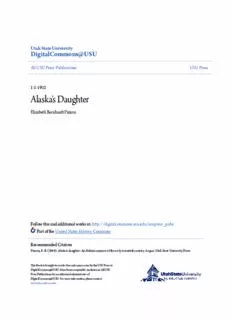
Alaska's Daughter PDF
Preview Alaska's Daughter
UUttaahh SSttaattee UUnniivveerrssiittyy DDiiggiittaallCCoommmmoonnss@@UUSSUU All USU Press Publications USU Press 1912 AAllaasskkaa''ss DDaauugghhtteerr Elizabeth Bernhardt Pinson Follow this and additional works at: https://digitalcommons.usu.edu/usupress_pubs Part of the United States History Commons RReeccoommmmeennddeedd CCiittaattiioonn Pinson, E. B. (2004). Alaska's daughter: An Eskimo memoir of the early twentieth century. Logan: Utah State University Press. This Book is brought to you for free and open access by the USU Press at DigitalCommons@USU. It has been accepted for inclusion in All USU Press Publications by an authorized administrator of DigitalCommons@USU. For more information, please contact [email protected]. (cid:61)(cid:68)(cid:65)(cid:82)(cid:57)(cid:58)(cid:61)(cid:76)(cid:64)(cid:3)(cid:58)(cid:61)(cid:74)(cid:70)(cid:64)(cid:57)(cid:74)(cid:60)(cid:76)(cid:3)(cid:72)(cid:65)(cid:70)(cid:75)(cid:71)(cid:70) (cid:57)(cid:100)(cid:89)(cid:107)(cid:99)(cid:89)(cid:8)(cid:107) (cid:39)(cid:68)(cid:88)(cid:74)(cid:75)(cid:87)(cid:72)(cid:85) (cid:57)(cid:70)(cid:3)(cid:61)(cid:75)(cid:67)(cid:65)(cid:69)(cid:71)(cid:3)(cid:69)(cid:61)(cid:69)(cid:71)(cid:65)(cid:74)(cid:3)(cid:71)(cid:62)(cid:3)(cid:76)(cid:64)(cid:61)(cid:3)(cid:61)(cid:57)(cid:74)(cid:68)(cid:81)(cid:3)(cid:76)(cid:79)(cid:61)(cid:70)(cid:76)(cid:65)(cid:61)(cid:76)(cid:64)(cid:3)(cid:59)(cid:61)(cid:70)(cid:76)(cid:77)(cid:74)(cid:81) Alaska’s Daughter Alaska’s Daughter An Eskimo Memoir of the Early Twentieth Century Elizabeth Bernhardt Pinson Utah State University Press Logan, Utah Copyright © 2004 Elizabeth Bernhardt Pinson All rights reserved Utah State University Press Logan, Utah 84322-7800 Cover design by Bret Corrington and Curt Gullan Map by Tom Child Photos from the collection of the author Manufactured in the United States of America Printed on acid-free paper Library of Congress Cataloging-in-Publication Data Pinson, Elizabeth Bernhardt, 1912- Alaska’s daughter : an Eskimo memoir of the early twentieth century / by Elizabeth Bernhardt Pinson. p. cm. ISBN 0-87421-596-X (alk. paper) -- ISBN 0-87421-591-9 (pbk. : alk. paper) 1. Pinson, Elizabeth Bernhardt, 1912- 2. Iñupiaq women--Alaska--Teller--Biography. 3. Iñupiaq women--Alaska--Teller--Social conditions. 4. Iñupiaq--Alaska--Teller--Social life and customs. 5. Teller (Alaska)--History. 6. Teller (Alaska)--Social life and cus- toms. I. Title. E99.E7P517 2004 979.8004’9712’0092--dc22 2004016131 To my father and my teenaged brother Tommy, who risked their lives traveling through a cold cruel world of ice and snow to save my life Thank you to my nephew John Reimer, who, along with his wife Catherine and her sister Coleen Engle, retyped the original manuscript in a word processing program. Foreword Bret Corrington O nce in a while, maybe only a few times in a lifetime, we stumble upon something truly unique and undeniably beautiful. I met Elizabeth B. Pinson, “Betty,” on a park bench in Seattle the summer of 2002. This was clearly one of those moments. Never before had I encountered a stronger embodi- ment of the human spirit, courage, and grace. At ninety years old, this half German, half Iñupiaq Eskimo from Teller, Alaska, held more life in her eyes than many a quarter her years. Though our encounter was brief, it would mark an important point in both our lives, and the beginning of a very spe- cial relationship. Because of it her manuscript fell into my hands. Every year in August, a time in the Northwest when dark clouds seem most reluctant to blanket the skies, a reunion is held. This reunion is not centered on a family or graduating class; rather, it is centered on a town, the small but infamous town of Nome, Alaska. Since 1972, past and present residents of Nome have fl ocked to Woodland Park in Seattle’s Greenwood district for what has come to be known as the Nome Picnic. Nomeites, as we like to be called, mill from table to table fi lling paper plates from vii viii Foreword Tupperware containers and brandishing nametags which include our years of residency. My nametag read: Bret, 73–75. I was born in Nome though until that summer had not attended the picnic. As luck would have it my mother, a Nomeite from 1967 to 1975, was visiting the same weekend the picnic was being held. We decided to go with nostalgic hopes of uncovering lost memories from what seemed like a different lifetime. More than anything, I imagine, I was hoping to hear stories about my parents when they were my age—maybe even hit the jack- pot with something vaguely incriminating that would make for interesting conversation over Christmas dinner. What I would hear instead would be a bit more profound. I loaded a fresh roll of fi lm into my camera as my mother and I coasted along slowly down the park drive looking for picnic site twelve where the reunion was being held. Large-leafed maple trees fi ltered the sunlight in broken patches across the green of the park and the blacktop, leaving some patches slightly cooler in the wake of the shade. That summer began my senior year in college, and I was enrolled in a black and white photography class. I imagined this gathering of displaced Alaskans to be an ideal opportu- nity to get some interesting photographs. As we pulled into the parking lot of site twelve, a group of mingling picnickers standing under the shade of a large shelter came into focus through the lens of my camera. We were greeted by the Gallehers, dear friends of my parents who once ran a small airline out of Nome and now live in the Norwegian com- munity of Poulsbo, Washington. After several introductions, I sank into the milling of the crowd, in search of photographs and stories of my own. Making my way around the grounds, snapping off candid shots here and there, I eventually came upon a kind elderly woman whose name tag read: Ruth, 32–37. Not wanting to be intrusive with my camera, we spoke for quite a while before I asked permission to take her photograph. A moment later, a younger woman approached and slightly out of breath announced that Betty had just arrived and was about to tell her story. I helped Ruth to the area where I was told Betty was sitting. As we came upon a picnic table nestled in the shade, others were arriving and eager to listen. Some, I am sure, had heard Betty’s story many times before, but for others including me, this would be a fi rst. Ruth sat down and was met with a warm smile. There, delicate and kind with soft blue eyes contrasting her Eskimo features, sat Betty, poised and elegant. She reached over and gave
Description: